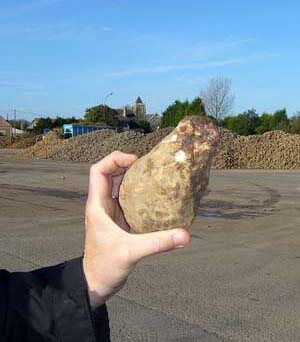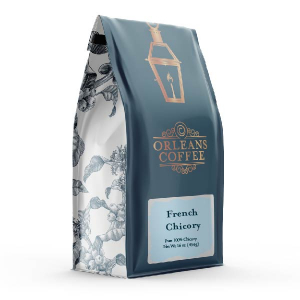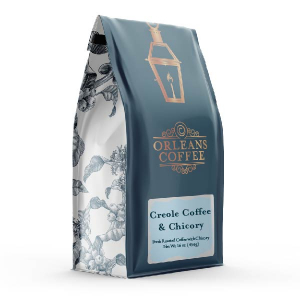Chicory is the roasted and ground root of the cultivated plant species, Chicorium Intybus, subspecies Sativum. Common names include ‘large rooted chicory’ and ‘chicoree a café’. Chicory is used worldwide as a drink or included in the brewing of coffee. Chicory has a similar flavor to coffee, which is why some people use plain chicory as a decaf coffee substitute.
- What Does It Taste Like?
- Other Uses For Chicory
- History of Chicory
- Chicory’s Wartime History
- A New Orleans Tradition
- What are the health benefits of chicory?
The History of Coffee & Chicory
Coffee & Chicory is the traditional favorite of many a New Orleans native. The blends are best enjoyed with a dose of warmed milk in the “au lait” style. We mix estate-grade coffees with the highest quality French and/or American chicory to produce a traditional and distinctive flavorful beverage.

Coffee chicory is grown in many parts of the world, with the largest producers in France and South Africa, and now in the U.S. in the state of Nebraska. The root is grown and harvested much like sugar beets. The roots are pulled from the ground with specialized equipment, cut into small pieces, kiln-dried, roasted, ground, and packaged.
High concentrations of the carbohydrate inulin are caramelized during roasting and converted into d-fructose (fruit sugar). It also contains between 4 and 6 percent protein and a small quantity of fiber. The caramelized fruit sugar gives chicory its distinctive dark brown color while increasing sweetness and reducing the bitterness that is characteristic of the raw root. Roasted chicory contains none of the volatile oils and aromatics that are contained in roasted coffee. It also contains no caffeine. It does however yield 45 to 65% of soluble extractive matter, while coffee yields only 20 to 25%. This difference explains why less coffee and chicory can be brewed while still resulting in a beverage that looks (and tastes) quite strong.
What Does It Taste Like?
The raw chicory root tastes bitter. The root after roasting, however, is delicious! During roasting, toasty and nutty flavors come out, making for a delicious flavor to add to your coffee or to enjoy alone. The scent of the roasted root keeps some of the initial bitterness, making the smell not dissimilar to coffee. However, chicory doesn’t taste exactly like the coffee you know and love. Instead, you get more of the strong nutty and roasted flavors including the flavor of caramelized sugar.
Other Uses For Chicory
The roots of other subspecies of Chicorium Intybus are used for the production of the ‘forced’, grown in the dark, vegetables known as Belgian or French Endive also known as ‘Chicon’ and Witloof chicory. The root is also used as a ‘feedstock’ for the manufacture of inulin, which is used as a sweetening agent for low-fat and reduced-calorie foods. The leafy portion of the plant is often used as animal fodder in Europe, while in the U.S. it is generally considered a noxious weed. The blanched (to reduce bitterness) leaves can be used as a salad green.
Commercially available coffee chicory is not derived from the root of the endive plant. Endive is the sister species Chicorium Endivia, popularly known as the salad green ‘escarole’ or ‘curly endive. The root of Chicorium Endivia has undoubtedly been used in the past as a coffee substitute, but it is not commercially used for that purpose today.
-
 Decaf Creole Coffee & Chicory Blend$13.50
Decaf Creole Coffee & Chicory Blend$13.50 -
 Pure French Chicory$4.50 – $16.50
Pure French Chicory$4.50 – $16.50 -
 Creole Coffee & ChicoryOriginal price was: $12.25.$10.75Current price is: $10.75.
Creole Coffee & ChicoryOriginal price was: $12.25.$10.75Current price is: $10.75.
History of Chicory
The word ‘Chicory’ is probably derived from the Egyptian word ‘Ctchorium’. In various forms ‘Ctchorium’ has become the name of the plant in practically every European language. Originally used to describe the wild plant, its use over time was extended to the cultivated form as well. The use of the wild foliage as an animal feed probably coincided closely with its first use as human food, which undoubtedly predated recorded history.
Chicory was cultivated as early as 5000 years ago by Egyptians as a medicinal plant. Ancient Greeks and Romans used chicory as a vegetable and in salads. References exist in the writings of Horace, Virgil, Ovid, and Pliny. Galenus gave it the name ‘Friend of the Liver’, because of its supposed stimulating effect on that organ. Cultivation as animal forage in northern Europe began in the early 17th century. The wild root may have been used for food, but it is likely that it was a last resort, since the wild root is woody and incredibly bitter. Cultivated roots, (when young and tender) on the other hand, are consumed to this day, particularly in Belgium.
Chicory’s Wartime History
Exactly when the root was first roasted to be used as a coffee substitute is unclear. There are references to the use of wild chicory root as a coffee additive in colonial America. It is known that its use in this form was widespread in France after Napoleon initiated the ‘Continental Blockade’ in 1808, which deprived the French of most of their coffee.
When the blockade was lifted the French continued to use chicory as an additive because they believed it was good for one’s health and improved the flavor of coffee. In the 19th century, its use as a coffee additive and substitute became widespread in France and areas of French cultural influence like Louisiana. Chicory use grew with the advent of the Civil War. As trade disruptions and blockades disrupted deliveries of coffee, citizens, and soldiers made do by roasting wild chicory root. Other ingenious substitutes like corn and ground nuts were also used during the time.
But this was a substitution of necessity, not choice. So, when the war ended, chicory use decreased as prosperity improved and coffee became more readily available. Except in New Orleans and parts of Louisiana where its use was a matter of preference not a necessity. Of course, chicory use, as an economical additive in coffee is widespread throughout the world. But, in New Orleans, this economic rationale ignores the influence of 19th-century French culture on our cuisine. Additionally, it does nothing to explain our continued preference for coffee & chicory, even when chicory becomes more expensive than many coffees.
A New Orleans Tradition
New Orleanians hang onto their culinary traditions with a vengeance. We have consumed coffee and chicory for over two hundred years and will do so for another two hundred. While espresso, cappuccino and exotic coffees from around the world are available here as they are available everywhere, one can rest assured that a café au lait in New Orleans will be made with rich black coffee & chicory and boiled milk, just as it was two centuries ago.
What are the health benefits of chicory?
Chicory has been thought to have medicinal qualities for over 5,000 years. What follows is a listing of some of the reputed health benefits of chicory. Whether historical or current, please be aware that we are neither endorsing nor reputing any of these claims. We just think they are pretty interesting.
- Early 19th century French chefs and writers believed chicory to be a ‘contra-stimulante’. That is, the sedative effects were a perfect complement to the stimulating effects of the caffeine in coffee. On the other hand they believed its use by ‘bloodless’ or ‘lymphatic’ persons should be avoided.
- The fresh root has been said to be useful against pulmonary consumption. A decoction of 1 oz of root to a pint of boiling water has been found to be effective against jaundice and liver enlargement.
- Syrup of chicory is said to be an excellent laxative for children since it works without irritation.
- Ancient herbalists considered the bruised leaves to make a good poultice for swelling and inflamed eyes.
- Modern herbalists say chicory increases bile production, moderates a rapid heart rate, lowers cholesterol and destroy bacteria.
- A recent Korean study indicates that that chicory reduces cholesterol levels. It increases the ratio of HDL (the good stuff) to LDL (the bad stuff) in the blood of tested animals.
-
 Decaf Creole Coffee & Chicory Blend$13.50
Decaf Creole Coffee & Chicory Blend$13.50 -
 Pure French Chicory$4.50 – $16.50
Pure French Chicory$4.50 – $16.50 -
 Creole Coffee & ChicoryOriginal price was: $12.25.$10.75Current price is: $10.75.
Creole Coffee & ChicoryOriginal price was: $12.25.$10.75Current price is: $10.75.
